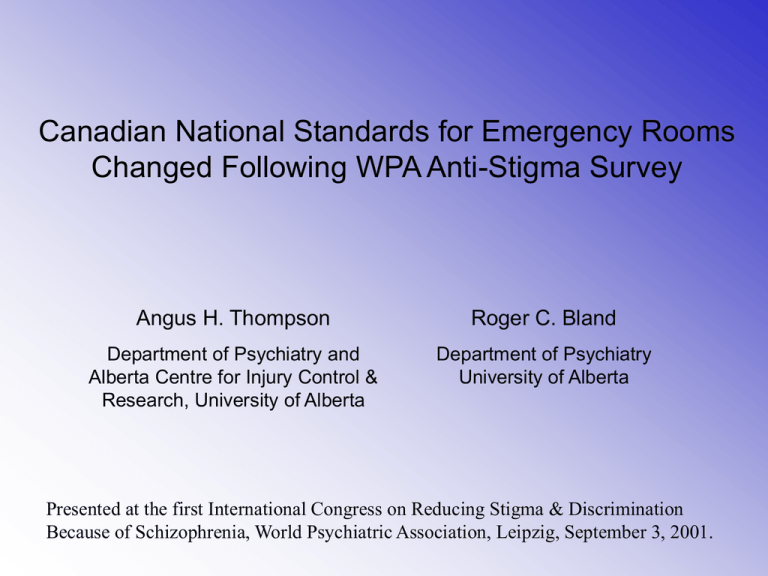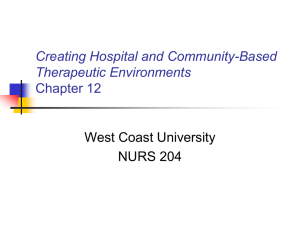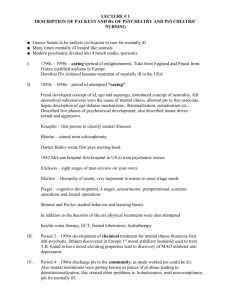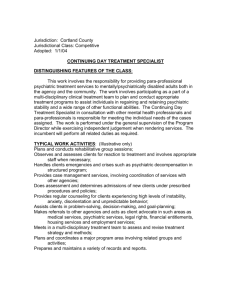Canadian National Standards for Emergency
advertisement

Canadian National Standards for Emergency Rooms Changed Following WPA Anti-Stigma Survey Angus H. Thompson Roger C. Bland Department of Psychiatry and Alberta Centre for Injury Control & Research, University of Alberta Department of Psychiatry University of Alberta Presented at the first International Congress on Reducing Stigma & Discrimination Because of Schizophrenia, World Psychiatric Association, Leipzig, September 3, 2001. WPA CAMPAIGN AGAINST THE STIGMA OF SCHIZOPHRENIA: ALBERTA PILOT PROJECT Local Advisory Committee, Sub-Committee on Health Professions Julio Arboleda Florez, MD, PhD Chair, Psychiatry Queens University Laurie Beverly, MN Cont Care Mgr Roger Bland, MB Chair, Psychiatry University of Alberta Ruth Dickson , MD Dir., Psychiatry P. Lougheed Hospital Beth Evans, BA Pr. Coordinator Alberta MH Board Marion Ewing, RPN ER Manager Drumheller Health Reg. Michelle Misurelli Consumer Calgary Angus Thompson, PhD, Chair Psychologist University of Alberta Elizabeth Anderson Consumer Calgary Calgary Health Reg. Pilot Site for the WPA Campaign Against the Stigma of Schizophrenia ALBERTA WPA Pilot Sites METHODS Phase 1 Methods 1. The Sub-Committee identified Emergency Room (ER) services at general hospitals as a problem for the mentally ill because of attitudes, behaviours and facilities. Phase 1 Methods 1. The Sub-Committee identified Emergency Room (ER) services at general hospitals as a problem for the mentally ill because of attitudes, behaviours and facilities. 2. The Sub-Committee prepared a questionnaire covering privacy/security, restraints, patient rights, training of staff, patient satisfaction, and planned changes. Phase 1 Methods 1. The Sub-Committee identified Emergency Room (ER) services at general hospitals as a problem for the mentally ill because of attitudes, behaviours and facilities. 2. The Sub-Committee prepared a questionnaire covering privacy/security, restraints, patient rights, training of staff, patient satisfaction, and planned changes. 3. The questionnaire was completed by the ER program managers in Calgary (3) & Drumheller(1). World Psychiatric Association Anti-Stigma Campaign EMERGENCY ROOM QUESTIONNAIRE (Item Content) • Adequacy of interview space (safety, security & privacy). • Availability of security staff. • Formal patient rights policy (Existence and provision to patients/family). • Restraints policy (Existence). • Availability of specialist (mental health emergencies) staff on-site. • Adequacy of ER staff training (CME, in-service) in managing mental health crises. • Evidence for equal access/quality of treatment for the mentally ill (e.g. wait times). • Adequacy of evaluation of services. • Plans for any changes in the above areas. • Additional comments pertaining to the mentally ill in Emergency Departments. Survey Findings •3 (of 4 ERs) had adequate access to security staff Survey Findings •3 (of 4 ERs) had adequate access to security staff •2 had adequate rooms for security & privacy Survey Findings •3 (of 4 ERs) had adequate access to security staff •2 had adequate rooms for security & privacy •3 had formal patient rights policies, one will provide these to patients/families on request Survey Findings •3 (of 4 ERs) had adequate access to security staff •2 had adequate rooms for security & privacy •3 had formal patient rights policies, one will provide these to patients/families on request •3 had specialist MH staff on site for limited hours, with “on call” availability for other times. The rural hospital had difficulty with staffing. Survey Findings •3 (of 4 ERs) had adequate access to security staff •2 had adequate rooms for security & privacy •3 had formal patient rights policies, one will provide these to patients/families on request •3 had specialist MH staff on site for limited hours, with “on call” availability for other times. The rural hospital had difficulty with staffing. •CME for psychiatric emergencies was not required, & the rural hospital had no formal inservice training. Survey Findings •3 (of 4 ERs) had adequate access to security staff •2 had adequate rooms for security & privacy •3 had formal patient rights policies, one will provide these to patients/families on request •3 had specialist MH staff on site for limited hours, with “on call” availability for other times. The rural hospital had difficulty with staffing. •CME for psychiatric emergencies was not required, & the rural hospital had no formal inservice training. •None had outcome or satisfaction data Phase 2 Methods 1. A Report of the findings was distributed to the ER Managers and to the Regional Patient Care Manager. Phase 2 Methods 1. A Report of the findings was distributed to the ER Managers and to the Regional Patient Care Mgr. 2. Discussions were held with the Canadian Council on Health Services Accreditation (CCHSA) -- the national hospital accreditation body. Phase 2 Methods 1. A Report of the findings was distributed to the ER Managers and to the Regional Patient Care Mgr. 2. Discussions were held with the Canadian Council on Health Services Accreditation (CCHSA) -- the national hospital accreditation body. 3. The Sub-Committee, upon invitation, proposed changes to the CCHSA accreditation protocol. PROPOSED ER GUIDELINES FOR PATIENTS WITH A MENTAL ILLNESS PROPOSED ER GUIDELINES General Headings P1.0 The examination and interview process and space are adequate for the safety, security, and privacy of patients and staff PROPOSED ER GUIDELINES General Headings P1.0 The examination and interview process and space are adequate for the safety, security, and privacy of patients and staff P2.0 There is a client/pt. /family rights policy that defines its application to mentally ill individuals PROPOSED ER GUIDELINES General Headings P1.0 The examination and interview process and space are adequate for the safety, security, and privacy of patients and staff P2.0 There is a client/pt. /family rights policy that defines its application to mentally ill individuals P3.0 Staff will be available who have competence in the management of mental health emergencies PROPOSED ER GUIDELINES General Headings P1.0 The examination and interview process and space are adequate for the safety, security, and privacy of patients and staff P2.0 There is a client/pt. /family rights policy that defines its application to mentally ill individuals P3.0 Staff will be available who have competence in the management of mental health emergencies P4.0 The quality of services to psychiatric patients will be evaluated CONSEQUENCES Consequences 1. The Report led some ERs to seek funding to remedy individual deficiencies, and there was an expressed wish to have more clearly defined standards. Consequences 1. The Report led some ERs to seek funding to remedy individual deficiencies, and there was an expressed wish to have more clearly defined standards. 2. The report was used by the hospitals for their local reviews and in preparation for the next round of accreditation surveys by the CCHSA. Consequences 1. The Report led some ERs to seek funding to remedy individual deficiencies, and there was an expressed wish to have more clearly defined standards. 2. The report was used by the hospitals for their local reviews and in preparation for the next round of accreditation surveys by the CCHSA. 3. The CCHSA considered the Sub-Committee recommendations (& those from other sources). • All but one were completely adopted • The exception (a private interview room) was partially endorsed. DISCUSSION Discussion Consumer input can lead to a change in national hospital service standards, dependent on: Discussion Consumer input can lead to a change in national hospital service standards, dependent on: 1. Consumer identification of a valid issue Discussion Consumer input can lead to a change in national hospital service standards, dependent on: 1. Consumer identification of a valid issue 2. A "win-win" relationship with the hospitals Discussion Consumer input can lead to a change in national hospital service standards, dependent on: 1. Consumer identification of a valid issue 2. A "win-win" relationship with the hospitals 3. Early collaboration with our national accreditation body Discussion Consumer input can lead to a change in national hospital service standards, dependent on: 1. Consumer identification of a valid issue 2. A "win-win" relationship with the hospitals 3. Early collaboration with our national accreditation body 4. Luck! ACKNOWLEDGEMENTS Judith McLeay ER Manager Foothills Hospital Donna Kelly ER Manager Peter Lougheed Centre Lois Reister ER Manager Rockyview Gen. Hospital Beth Dorsey Regional Pt Care Mgr Psych Emerg Calgary Regional Health Authority Paula Greco Canadian Council on Health Services Accreditation www.cchsa.ca FIN World Psychiatric Association Anti-Stigma Campaign EMERGENCY ROOM QUESTIONNAIRE The World Psychiatric Association is leading an international health campaign to reduce the stigma associated with schizophrenia. Calgary and Drumheller were chosen by an international committee to be a pilot site for the implementation of this campaign, which includes the development of materials for use in other jurisdictions worldwide. One of the areas identified was emergency room services. The goal for this part of the campaign is that persons with schizophrenia and other mental illnesses will be viewed as being as important as those with physical illness. We would appreciate your help in reviewing Emergency Room service in your region by providing the following information for your Emergency Department. •.Is adequate, safe, secure space, ensuring reasonable privacy, available for the examination and interview of psychiatric patients and their families? •.Is security staff available? •.Is there a written statement of patient rights in your hospital? If so, how and when is it provided to psychiatric patients who present at the ER? •.If restraints are used, is there a policy in place? (Please provide copies, if available). •.Do you provide on-site staff who are trained in managing mental health emergencies? If yes (circle one): At all times At specified hours only On call only A combination of the above (please provide details) •.Are your Emergency Room medical staff trained in managing mental health crises? Are they required to participate in CME in this area? How does this compare with requirements, training, and qualification in other areas of medicine? •.Are your other staff (e.g. nurses) trained in managing mental health emergencies? If trained, how did they receive the training? Is there any in-service requirement in this field? •.If you have data on whether wait times differ in any way from those with other illnesses or conditions, please provide the most recent results. •.If you have data on patient (mental health) and family satisfaction with your Emergency Room services, please provide a copy of the most recent results. Please include data, if possible, drawn from patients with other illnesses. Is such data collected on a regular basis? •.Do you have plans for any changes in the above areas? •.Do you have any comments pertaining to the care of the mentally ill in Emergency Departments? PROPOSED ER GUIDELINES FOR PATIENTS WITH A MENTAL ILLNESS Detailed Recommendations ER GUIDELINES: PATIENTS WITH A MENTAL ILLNESS P1.0 The examination and interview process and space are adequate for the safety, security, and privacy of patients and staff P1.1 There are enough private interview rooms available to ensure privacy during interviews in most situations P1.2 Interview rooms are secure P1.3 Security staff are available on a timely, as needed, basis P1.4 There is a policy in place governing the use of restraints ER GUIDELINES: PATIENTS WITH A MENTAL ILLNESS P2.0 There is a client/pt. /family rights policy that defines its application to mentally ill individuals P2.1 Information on rights is provided to the patient P2.2 These rights are provided in a timely manner P2.3 There is a policy whereby an interested second party is consulted when the patient’s mental illness interferes with the understanding of these rights P2.4 There is a process for obtaining consent on behalf of a patient when mental illness interferes with understanding of the intervention being offered P2.5 There is a process for deferring the above provisions in emergent cases P2.6 There is a process for patients & families to voice concerns about rights violations ER GUIDELINES: PATIENTS WITH A MENTAL ILLNESS P3.0 Staff will be available who have competence in the management of mental health emergencies P3.1 Staff will be available who are qualified to manage mental health emergencies P3.2 In-service training is provided to fill any gaps in staff skills P3.3 Staff will have acquired a “sensitivity” to mental illness ER GUIDELINES: PATIENTS WITH A MENTAL ILLNESS P4.0 The quality of services to psychiatric patients will be evaluated P4.1 There is information on whether wait times for psychiatric patients differ from those with other illnesses or conditions P4.2 Information on patient and family service satisfaction is gathered P4.3 Information is gathered on the quality of treatment provided to ER psychiatric patients





